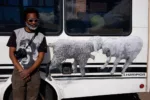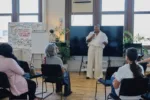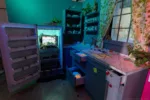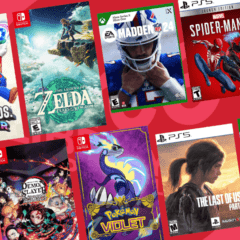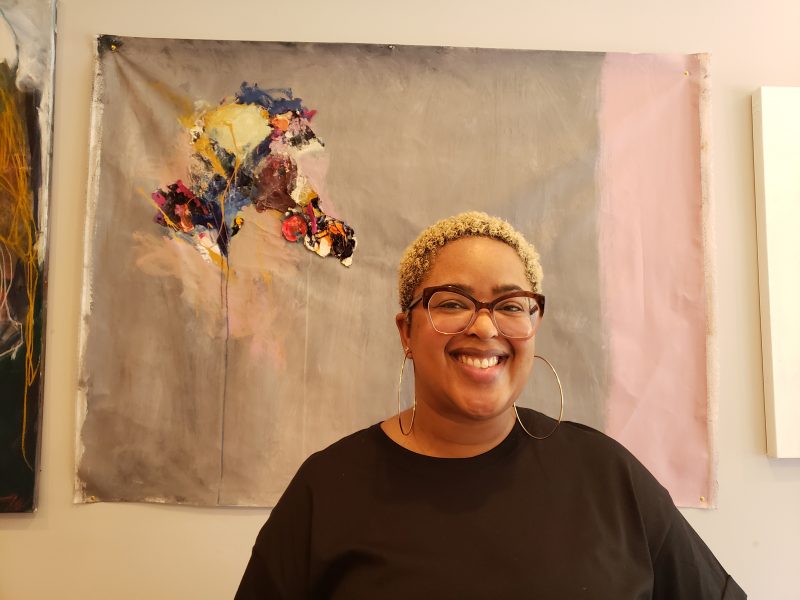
In October of 2018, a new gallery and arts collective centering the needs of women and nonbinary abstract artists of color sprang to life in the heart of the Kensington section of North Philadelphia. The founder, A’Driane Nieves, saw that there was a dearth of resources available to artists like herself and wanted to do what was needed to bridge that gap. From her diligence, Tessera Arts Collective was born. Since its inception, Tessera Arts Collective has provided resources and display opportunities to the demographic of artists they serve not just in the Philadelphia region, but across the United States as well. If you’re currently practicing social distancing due to COVID-19, you can still check out a public art project by Tessera! There are five wheat-pasted works by Symone Salib of art celebrating abstract women artists like Bernice Bing, Carmen Herrera, and three others strategically placed around Philadelphia! Follow Tessera Arts Collective on social media to find out more about the project and their future programming.
Wit López: So A’Driane, you’re the founder of Tessera Arts Collective. Can you tell us more about the mission, vision, and values of the organization?
A’Driane Nieves: Sure, I will start by saying that originally, I wanted to create some type of space that I myself as an abstract, Black, queer, woman artist did not have. I wanted to create a space where I could show my own work, which is abstract, and I could find other Black and brown abstract women artists to connect with and show their work. I wanted to create a space that, honestly, was very niche, but that has not existed. That’s really where the genesis for this came from.
Originally, my focus was on women-identifying artists of color and over time that changed, through the encouragement of a very astute board member who understands me very well—we were doing an exercise with all these Post-its on the wall and we were writing down all these things that I envisioned for Tessera. On one Post-it, I had written that we elevate women-identifying and nonbinary abstract artists of color and I put it up. She watched me come back to my seat and sit down, she got up, walked over to it, grabbed it, and put it right in the middle of the board, and said, “That’s your mission. That’s the heart of it because that’s you.” For about six to nine months, I had been very afraid to zero in on that and to shift towards that because I didn’t want to appear like I was trying to exclude other artists, but she’s right, that’s the heart of it. We made that shift in focus. Our mission is to support women, including queer, trans, femme, and nonbinary abstract artists of color in the Greater Philadelphia Area, and also around the country, by providing opportunities, resources, and programming that elevates their work and their practice.
We currently operate a storefront gallery and studio here in the Kensington neighborhood of North Philadelphia, where my mother’s family is originally from. Our focus is to propel these artists to take their rightful place in the art world by providing a refuge for them to incubate and nurture their creativity. At the same time, we want to make sure that we are honoring the contributions of these artists to the larger canon of abstraction. Whether that is honoring those who have come before us, like our foremothers or what we call the GOATs*, the greats, who have paved that way for us, we want to make sure that we are honoring them and at the same time, increasing the visibility for those who are creating right now, so we don’t miss out on a Bernice Bing, who was way overlooked and didn’t get a chance to be as widely recognized as she should have been during her lifetime. There’s more awareness about her now and her work is starting to become highly acclaimed now, but I wonder what that would have looked like for her during her lifetime. We want to honor those who have paved the way for us and who have passed on and those who are still here in their 70s and 80s—I mean, Carmen Herrera is 104!
We want to make sure that we give them their flowers. We don’t want to wait until they’re already gone, but at the same time, we want to make sure that the ones who are coming behind them and who are discovering abstraction for the first time, from those who are doing art as a hobby to those who are pursuing it as a career, have the resources, the opportunities, the access. We want to make sure we hold space for them.
WL: It takes a lot to make abstract work that is… good [laughs]. I feel like “good” is a subjective word, but to make something that draws people in and that has depth and texture, that takes a lot of work.
AN: It does. I was talking to someone last weekend about this and also how I personally feel that as a Black person, especially, if you have had to fight for your survival, nothing about your existence or your imagination is abstract. Everything has to be concrete and tangible. Everything! So you don’t really have the privilege or the luxury of even being able to think about your lived experiences and your emotions through an abstract lens. I really feel that people of color, especially, have a pretty significant disconnect with abstraction and another reason why I wanted to create a space like this in a community was to be able to give people that kind of access. When I held the opening reception here, my husband’s cousins—they’re Puerto Rican—came, I had some friends and family come, but 95% of the people who came that night were Black or brown. I had someone come up to me and say, “I’ve never been to an art opening,” and another who said, “I’ve never been to an art opening where it was just us.” It was just us and we were looking at abstract art; I had never experienced this before.
I remember one gentleman, he was going to the barbershop a couple of doors down and we were outside and he said, “I walk by here all the time, is this a gallery? What do you do?” I told him what we do and I told him to come inside and take a look. He said, “I’m wearing flip flops and socks.“ So I said, “You see how I’m dressed?” It goes to show, in our minds, a gallery space is sterile and white. Here, it’s like you’re walking into someone’s living room versus going into an art gallery somewhere else in the city where the walls are white and all the art is separated from each other and you have to be quiet. I wanted to create a completely different vibe and access point with this, which is why we have throw pillows and plants, and rugs to make it feel more home-y. Yes, you’re looking at fine art, but it’s in a way to let you know that it’s for you to access.
I talk a lot about that with people. My hope, my goal, even as an artist myself the works that I’m creating now are larger in scale, but I also want them to be very tactile. I want people to be able to touch them. My younger two are autistic and I’ve learned a lot about our sensory system and how you can learn so much about yourself and the world and your place in it through tactile input. It can ground you, so you have an awareness of where you are in space. If the goal is to get people of color to engage with abstraction in a way that they haven’t before and to build a connection and a relationship with it, then I believe that one way we can do that is through touch. You have a much different experience than just standing back and staring at a piece on the wall. I could talk about this all day!
WL: I could too! Most of my art is touchable art because I’m on the autism spectrum and I have ADHD. Touching things is something I was punished for as a child, so I make a lot of pillows in my work as a way for people to stim while they are in a public space. I appreciate that you’re bringing up this topic and making your work accessible in that way. That’s really cool.
AN: There’s layers to this for me, as an artist and as an arts administrator who didn’t go to school for either. I’m finding my way through it and learning a lot in the process.
WL: And you’re doing such a wonderful job! It’s exciting!
AN: Thank you! I’m trying.
WL: Can I ask you about the hashtag #5WomenArtists project that you’re going to be a part of?
AN: Yes! Most definitely. We are doing a street art campaign with local artist Symone Salib. You’ve seen her all over the city. Symone is one of the first artists I reached out to, to see if I could have some of her work here for our opening reception back in October 2018 and she graciously said yes, and was so supportive. I reached back out to her after talking to the board about it. They were very excited. I told her that the National Women in the Arts museum in DC has a “5 Women Artists” campaign that they do every March for Women’s History Month. Each year they ask cultural organizations to sign up to do some event around naming, identifying, and celebrating at least five women artists. We thought it would be great to highlight specifically Black and brown women abstract artists. You look at artists like Howardena Pindell and Barbara Chase-Riboud, who are Philly natives, and you look at their work, you see that they have used it in some way, shape, or form to talk about racial justice and things that impact women. They gave us a new lens to look at our own experiences through. They changed not just the art world, but also culture and society just by choosing abstraction over other styles. Since they’re from Philly, we wanted to honor them.
*GOAT is an acronym that stands for “greatest of all time.”
Tessera Arts Collective, 2568 Frankford Ave, Philadelphia, PA 19125


